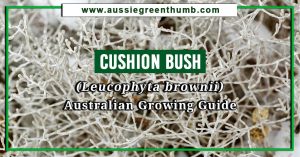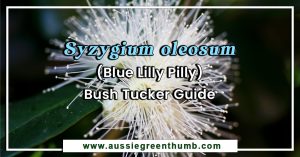With their dramatic foliage and spectacular structure, there are few plants that offer as much interest in the garden as staghorn ferns. While they can be challenging to get established, once they colonise a tree, container, or timber base they can live for many years with minimal care.
However, like any fern, the care regimen is quite unique compared to your typical garden plants and much more focussed on humidity than water or light.
Keep reading for our full guide to growing staghorn fern, including its origins, habitat preferences, and the subtle difference between each of the eighteen recognised species.
More...
Family: | Polypodiaceae |
|---|---|
Genus: | Platycerium |
Common Names: | Staghorn Fern, Elkhorn Fern |
Location: | Indoor or outdoor |
Type: | Fern, Perennial |
Growth: | up to 4m x 4m |
Sun requirements: | Part shade |
Foliage Colour: | Green |
Flower Colour: | None |
Flowering: | None |
Fruit: | None |
Maintenance level: | Low |
Poisonous for pets: | Non-toxic to cats and dogs |
What is a Staghorn Fern?
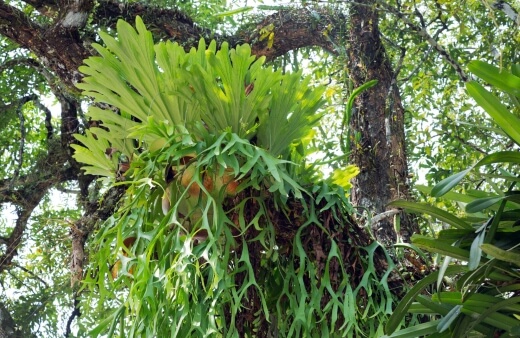
Staghorn ferns are a group of plants in the genus Platycerium, which is a relatively rare member of the polypod family (ferns to you or me).
While most ferns are built of multiple leaf-like structures along each frond, the fronds of staghorn ferns are much more singular in appearance, with a structural basal frond that exists to protect fern roots from sunlight, and a fertile frond, which gives the genus its common name; staghorn.
The curved, twisted, and pointed fertile fronds produce spores, which land on moist bark before developing into new plants. The fronds of staghorn ferns are generally fan-shaped, or bowl-shaped when grown in flat compost.
This adaptation helps them to catch water, leaf litter, and organic matter which they channel to their roots to feed the plant.
Staghorn Fern’s Natural Habitat
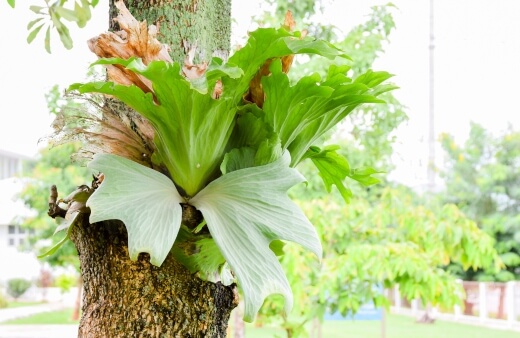
Ferns are some of the oldest plants on the planet, with genes dating back almost as far as the first Asparagaceae to find their way out of the sea. So you won’t be shocked to know that they are well established on almost every continent.
However, as continents drifted through warmer climates, some species developed to cope with higher temperatures and drier conditions, while others became humid, shade-loving plants.
Staghorn ferns or Elkhorn ferns fall into the prior category and are native to Australia, Madagascar, South America, South Asia, and most of the African continent.
They grow on soft-barked trees, in slight, but not deep, shade, where they draw moisture from the tree beneath its bark, and from the dripping waters after heavy rainfall.
Uniquely to staghorn ferns, they store water in their gigantic architectural leaves, making them well adapted to Australian gardens.
Best Staghorn Fern Varieties to Grow in Australia
There are four staghorn ferns that are native to Australia. These are Platycerium veitchii, Platycerium hillii, Platycerium angolense and Platycerium superbum (or Magnificent antler).
Despite having evolved in similar environments, the four could not be more different, but will each grow well in most Australian gardens, provided they have a warm, and reasonably humid position in an outdoor garden.
While they are the easiest to grow in our climate, there are eighteen other species which are equally simple to grow here, both indoors and out.
Staghorn Fern Species (A-Z)
1. Platycerium alcicorneP. alcicorne is native to Madagascar the Seychelles and some parts of mainland Zimbabwe and Mozambique. Its instantly recognisable fronds twist and turn, in what appears to be random directions. This is to provide a more open structure, which allows light and wind to pass freely, while still being able to capture moist leaf litter as it falls. Due to its size (over 1m when mature) it is best grown outdoors in Australia, either from spores on mature trees and logs or in well-drained but poor compost. | 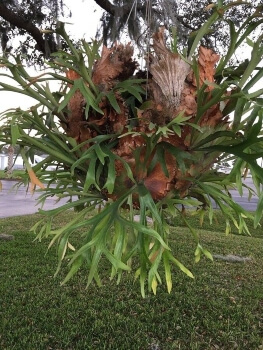 Source: identify.plantnet.org |
2. Platycerium andinumOne of the only staghorn ferns found natively in South America, P. andinum, commonly called staghorn ‘Blake’ has a trailing habit, with heavy, drooping fronds that hang down from branches in humid rainforests. Its basal fronds do most of the work and are well designed for moisture capture. If grown outdoors, they need regular watering or access to rain. |  Source: uk.inaturalist.org |
3. Platycerium angolenseP. angolese is native to central Africa and is found growing wild through Queensland. These ancient plants have adapted well to dry climates where rainfall is heavy but less common. Their giant ringed leaves will reach 2m easily in dappled light, and prefer to attach to mature trees where they benefit from dripping water. If left to fend for themselves they will develop brown fertile fronds in hot weather, but recover well each spring. | 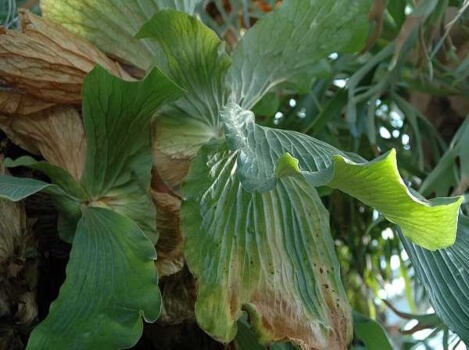 Source: prota4u.org |
4. Platycerium bifurcatumThe easiest way to identify P. bifurcatum is while it is spring. The spores create a thick mat of rusty coloured pustules on the underside of every fertile frond, leaving a crisp divide from the tips to the base of each leaf. Their palm-shaped fronds grow from dense, typically dark orange basal fronds which add a distinctive leaf form to any tropical garden. | 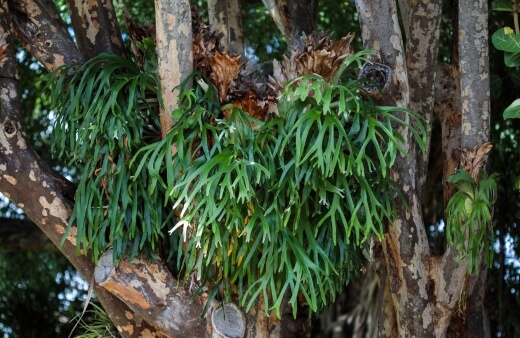 |
5. Platycerium coronariumThe combination of rigid basal leaves which stick up into the air (about 1m tall) and 4m long trailing fertile leaves is hard to miss, making P. coronarium one of the easiest staghorn ferns to identify. It will happily colonise on south-facing tree trunks but looks at its best when cultivated on planks on patios, where it benefits from a regular spray from the hose. | 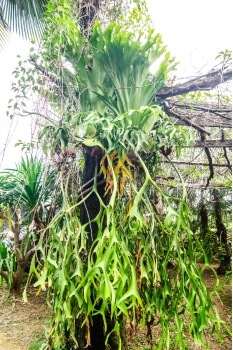 |
6. Platycerium ellisiiThe more compact fronds of P. allisii make it ideal for balconies or even growing as a houseplant, where it benefits from misting rather than watering and will grow well in either kokedama, or in poor, but moist compost. | 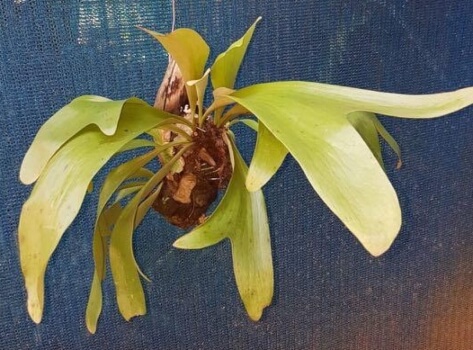 Source: carousell.sg |
7. Platycerium grande (Giant Staghorn Fern)Also called the giant staghorn fern, or lion’s cape, this beastly plant is nothing if not awe inspiring. Any tropical garden in Australia should consider growing one of these giant plants, with its vast sterile fronds, and dramatic fertile fronds, which tumble down the sides of trees and can cope well with more sun than most. | 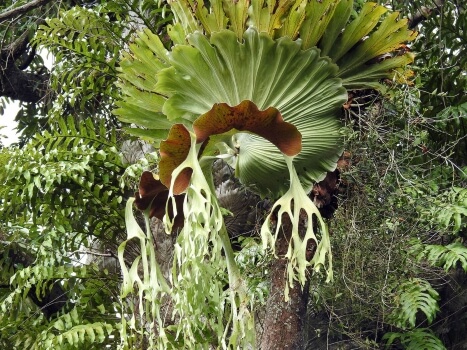 Source: powo.science.kew.org |
8. Platycerium hilliiP. hillii grows well as a houseplant, both because it is slow to grow, and fairly small at its final size (around 1m x 1m). The blue-green fronds have an exceptionally lovely dusty coasting which is ideal for adding native foliage into your garden, or home. | 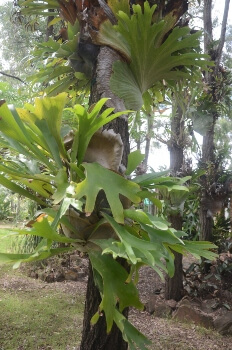 Source: ppnn.org.au |
9. Platycerium holttumiiP. holttumii is one of the most widely cultivated staghorn ferns, with an intensely formal shape, from its wide, flat top, to its dense trailing fronds which range from blues to whites in different conditions. By far the most reliable way to cultivate this Malaysian fern is by filling timber pallets with moisture retentive materials and hanging the entire thing from a wall, giving you much more control over this sturdy plant’s care. | 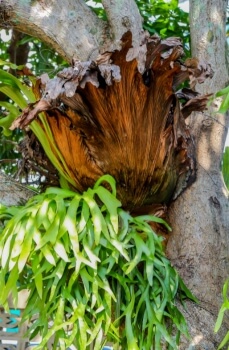 |
10. Platycerium madagascarienseNo prizes for guessing where Platycerium madagascariense is native. The bulbous basal fronds have alien-like forms, with deep ridges that burst out into short fronds at the top, with a distinctly brighter tone. They are easy to grow in most conditions, and can grow well in bark chippings with some soil mixed through. | 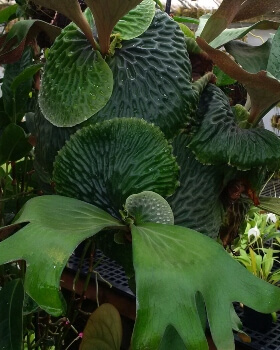 Source: exoticaesoterica.com |
11. Platycerium quadridichotomumP. quadridichotomum is easy to grow, but not the most spectacular fern in the world. Its dull fronds and typically brown basal fronds can be useful for naturalising a garden, but if it is impact you’re after, go for something slightly bigger and bolder. |  Source: powo.science.kew.org |
12. Platycerium ridleyi (Ridley's Staghorn Fern)There is no plant, whether indoors or out, that can rival P. ridleyi for sheer weirdness. The globular base is made up of multiple basal leaves, which cling tightly around its roots. This acts as a self-produced mulch to hold in any moisture that drips to them, which also protects them from sunlight. Its fronds are able to cope in brighter conditions too, making it ideal for most Australian gardens. | 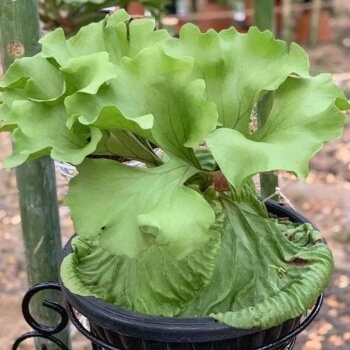 Source: tomorchid.com |
13. Platycerium stemaria (Triangle Staghorn Fern)At around 1.5m this is one of the bigger staghorns you can realistically grow in an average Australian garden. Its thick blue fronds are delicately dusty, with beautiful grass-green basal fronds above. This catches rainfall, and protects the lower fronds from the elements. It grows well on living trees, or old timber, so it’s fairly simple to propagate at home. |  Source: powo.science.kew.org |
14. Platycerium superbumTo be clear, this is pronounced Superb-Um, not Super-bum, but let’s face it, 99% of gardeners use the latter because it’s more fun. This gigantic, double-sided staghorn fern is native to Australia, with a perfect combination of upright and trailing fronds that attach to living or dead trees equally happily. If grown on a covered veranda, simply water it once a week with a spray hose. | 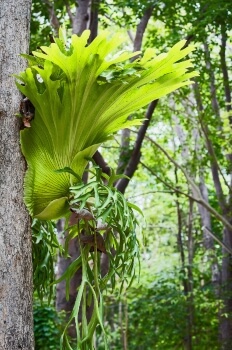 |
15. Platycerium veitchii (Silver Staghorn Fern)Commonly known as the silver Staghorn Fern, this species is native to Queensland, but grows well in cooler climates, and indoors too. It’s not frost hardy, so should be protected in that respect, but will cope with most conditions around the country. At full sizes, P. veitchii is less than 1m across, so great for balcony gardens. |  Source: uk.inaturalist.org |
16. Platycerium wallichiiNative to Southeast Asia, P. wallichii is really quite easy to grow here in Australia, and can be strapped into tree branches as young plants, painted on as spores, or grown in containers, or on boards. In all cases, its form is the same at around 1m x 1m, with verdant green fronds for most of the year. | 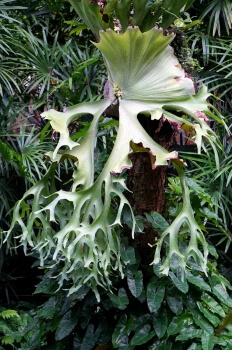 |
17. Platycerium wandae (Queen Staghorn Fern)Once in a while, you come across a plant and just fall in love. P. wandae is that for me. Its clumsy form and bulbous spread make it utterly adorable, with foliage that’s crying out to be watered. P. wandae is insanely simple to grow too, whether it’s in a pot, on a tree, or strapped into a fern plank. | 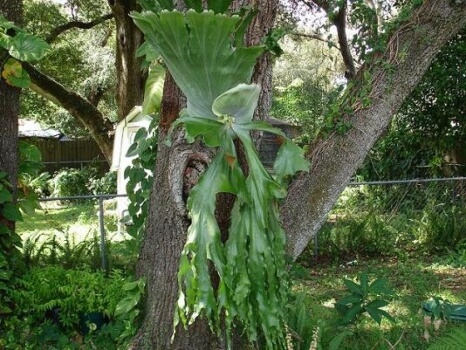 Source: buyraretropicalplants.com |
18. Platycerium willinckii (Java Staghorn Fern)The Java Staghorn has to be one of the most iconic species in this genus, with vast, but sturdy fronds, sticking out like sharply pointed fingers reaching out into the open air. It grows well on fences, walls, trees, planks and pretty much anywhere to convince it to root, with very little care. Generally speaking, this Java native plant only really needs feeding or watering when grown indoors. | Source: flower-db.com |
1. Platycerium alcicorne

Source: identify.plantnet.org
P. alcicorne is native to Madagascar the Seychelles and some parts of mainland Zimbabwe and Mozambique. Its instantly recognisable fronds twist and turn, in what appears to be random directions.
This is to provide a more open structure, which allows light and wind to pass freely, while still being able to capture moist leaf litter as it falls.
Due to its size (over 1m when mature) it is best grown outdoors in Australia, either from spores on mature trees and logs or in well-drained but poor compost.
2. Platycerium andinum

Source: uk.inaturalist.org
One of the only staghorn ferns found natively in South America, P. andinum, commonly called staghorn ‘Blake’ has a trailing habit, with heavy, drooping fronds that hang down from branches in humid rainforests.
Its basal fronds do most of the work and are well designed for moisture capture. If grown outdoors, they need regular watering or access to rain.
3. Platycerium angolense

Source: prota4u.org
P. angolese is native to central Africa and is found growing wild through Queensland. These ancient plants have adapted well to dry climates where rainfall is heavy but less common.
Their giant ringed leaves will reach 2m easily in dappled light, and prefer to attach to mature trees where they benefit from dripping water. If left to fend for themselves they will develop brown fertile fronds in hot weather, but recover well each spring.
4. Platycerium bifurcatum

The easiest way to identify P. bifurcatum is while it is spring. The spores create a thick mat of rusty coloured pustules on the underside of every fertile frond, leaving a crisp divide from the tips to the base of each leaf.
Their palm-shaped fronds grow from dense, typically dark orange basal fronds which add a distinctive leaf form to any tropical garden.
5. Platycerium coronarium

The combination of rigid basal leaves which stick up into the air (about 1m tall) and 4m long trailing fertile leaves is hard to miss, making P. coronarium one of the easiest staghorn ferns to identify.
It will happily colonise on south-facing tree trunks but looks at its best when cultivated on planks on patios, where it benefits from a regular spray from the hose.
6. Platycerium ellisii

Source: carousell.sg
The more compact fronds of P. allisii make it ideal for balconies or even growing as a houseplant, where it benefits from misting rather than watering and will grow well in either kokedama, or in poor, but moist compost.
7. Platycerium grande (Giant Staghorn Fern)

Source: powo.science.kew.org
Also called the giant staghorn fern, or lion’s cape, this beastly plant is nothing if not awe inspiring. Any tropical garden in Australia should consider growing one of these giant plants, with its vast sterile fronds, and dramatic fertile fronds, which tumble down the sides of trees and can cope well with more sun than most.
8. Platycerium hillii

Source: ppnn.org.au
P. hillii grows well as a houseplant, both because it is slow to grow, and fairly small at its final size (around 1m x 1m). The blue-green fronds have an exceptionally lovely dusty coasting which is ideal for adding native foliage into your garden, or home.
9. Platycerium holttumii

P. holttumii is one of the most widely cultivated staghorn ferns, with an intensely formal shape, from its wide, flat top, to its dense trailing fronds which range from blues to whites in different conditions.
By far the most reliable way to cultivate this Malaysian fern is by filling timber pallets with moisture retentive materials and hanging the entire thing from a wall, giving you much more control over this sturdy plant’s care.
10. Platycerium madagascariense

Source: exoticaesoterica.com
No prizes for guessing where Platycerium madagascariense is native. The bulbous basal fronds have alien-like forms, with deep ridges that burst out into short fronds at the top, with a distinctly brighter tone.
They are easy to grow in most conditions, and can grow well in bark chippings with some soil mixed through.
11. Platycerium quadridichotomum

Source: powo.science.kew.org
P. quadridichotomum is easy to grow, but not the most spectacular fern in the world. Its dull fronds and typically brown basal fronds can be useful for naturalising a garden, but if it is impact you’re after, go for something slightly bigger and bolder.
12. Platycerium ridleyi (Ridley's Staghorn Fern)

Source: tomorchid.com
There is no plant, whether indoors or out, that can rival P. ridleyi for sheer weirdness. The globular base is made up of multiple basal leaves, which cling tightly around its roots.
This acts as a self-produced mulch to hold in any moisture that drips to them, which also protects them from sunlight. Its fronds are able to cope in brighter conditions too, making it ideal for most Australian gardens.
13. Platycerium stemaria (Triangle Staghorn Fern)

Source: powo.science.kew.org
At around 1.5m this is one of the bigger staghorns you can realistically grow in an average Australian garden. Its thick blue fronds are delicately dusty, with beautiful grass-green basal fronds above.
This catches rainfall, and protects the lower fronds from the elements. It grows well on living trees, or old timber, so it’s fairly simple to propagate at home.
14. Platycerium superbum

To be clear, this is pronounced Superb-Um, not Super-bum, but let’s face it, 99% of gardeners use the latter because it’s more fun.
This gigantic, double-sided staghorn fern is native to Australia, with a perfect combination of upright and trailing fronds that attach to living or dead trees equally happily.
If grown on a covered veranda, simply water it once a week with a spray hose.
15. Platycerium veitchii (Silver Staghorn Fern)

Source: uk.inaturalist.org
Commonly known as the silver Staghorn Fern, this species is native to Queensland, but grows well in cooler climates, and indoors too.
It’s not frost hardy, so should be protected in that respect, but will cope with most conditions around the country. At full sizes, P. veitchii is less than 1m across, so great for balcony gardens.
16. Platycerium wallichii

Native to Southeast Asia, P. wallichii is really quite easy to grow here in Australia, and can be strapped into tree branches as young plants, painted on as spores, or grown in containers, or on boards.
In all cases, its form is the same at around 1m x 1m, with verdant green fronds for most of the year.
17. Platycerium wandae (Queen Staghorn Fern)

Source: buyraretropicalplants.com
Once in a while, you come across a plant and just fall in love. P. wandae is that for me. Its clumsy form and bulbous spread make it utterly adorable, with foliage that’s crying out to be watered. P. wandae is insanely simple to grow too, whether it’s in a pot, on a tree, or strapped into a fern plank.
18. Platycerium willinckii (Java Staghorn Fern)
Source: flower-db.com
The Java Staghorn has to be one of the most iconic species in this genus, with vast, but sturdy fronds, sticking out like sharply pointed fingers reaching out into the open air.
It grows well on fences, walls, trees, planks and pretty much anywhere to convince it to root, with very little care. Generally speaking, this Java native plant only really needs feeding or watering when grown indoors.
How to Grow Staghorns in Australia
Other than protecting staghorn ferns from cold, wet weather through winter, there is very little you need to worry about when growing them outdoors.
However, staghorn ferns are popular houseplants too and need slightly more attention than their outdoor friends.

Ideal Conditions for Planting Staghorns
Staghorn ferns are typically sold as young plants and are really quite simple to grow from that point onwards. All you need is good contact with any moisture retentive medium that it can root into, and hold onto.
Planting medium
Anything that your staghorn fern can root into to create a sturdy base. This can be the loose bark of a tree, or deeply ridged bark on mature trees, but could also be old pallet wood, or soft woods with moss growing over them.
If planting in a container, make sure it is incredibly well-drained, but packed with moisture-retentive material, like straw, bark mulch, or coir, which will hold moisture, but never pool.
(In the past, we suggested the use of peat/sphagnum moss. But, in light of its environmental impact, we've adjusted our recommendations to favor more eco-friendly alternatives that are equally or even more effective. Be sure to read our guide if you're interested in exploring peat moss and its substitutes.)
Watering Elkhorn Fern
Staghorn ferns can be watered in two ways; roots, or leaves. Their basal leaves tend to provide a cup or fan shape, which is where they would naturally catch rain in the wild.
Of course, in cultivation, their roots are attached to boards, timber, or potting mix, and can take in water that way too. Water when they need it and when their planting medium is slightly drying out to prevent over-watering.
Humidity
Humidity is perhaps even more important than water, with these forest plants that are incredibly well adapted to spring, and developing on moist tree trunks.
Once a week, mist your staghorn ferns (ideally using rain water). Where possible, mix a drop of balanced 10-10-10 fertiliser into the water once every few months to provide nutrients in as natural a way as possible.
Shade/Sun Preference
Staghorn ferns prefer partial shade and are generally found growing either under canopy shade or on the south side of trees, where they are less likely to suffer from direct dry heat.
However, for most of Australia, the more tropical species will grow quite happily in full sun, provided they are watered well through drought by spraying water at their base rather than their leaves.
How to Grow Staghorn Fern Indoors

Indoor staghorn ferns need watering and feeding in natural cycles, which for most ferns means an annual balanced feed, but they can benefit from some feed mixed into their watering once a month if you water with tap water.
Growing Elkhorn Fern In pots
Bulb baskets (see this bulb planting tray for reference) are similar to pond baskets, but work really, really for ferns, by allowing them to drain naturally.
They are effectively just containers for moisture-retentive plating mediums. Bark chippings, stripped bark, straw, or peat moss can all be used to fill fern baskets.
Fill a container with any moisture tentative medium (it doesn’t need to be nutritious) and plant young ferns directly into it. Water it well until the planting medium is saturated, and mist when it begins to dry out.
Growing Staghorn Fern Outdoors
Growing staghorn ferns outdoors is really quite simple and you don’t need a forest to do it. Below we’ll look at two simple options for planting staghorn ferns in Australian gardens, but first, think about the basic needs of your fern:
- Moisture
- Grip
- Shade
- Humidity
Growing Starhorns on Trees
If you have established healthy trees in your garden, that is probably the best place to plant a staghorn fern. The south side, out of direct light, but still with the benefit of summer temperatures is ideal.
To help your plants get started, pack some peat moss around the roots so that the roots don’t dry out while it takes hold, then tie the whole thing firmly onto the tree.
Branches or trunks are both fine, provided they are high enough for the fern to reach its full size without touching the floor.
Growing Staghorns on Timber
If you’ve got a balcony or small garden without established trees, you can still grow staghorn fern, and have the added benefit of them being standalone features that really pop when planted against a white wall.
Simply attach a fern to any timber board, preferably with moss growing, or fill a timber box with hay. Water it up really well, and secure your fern (roots first) to the base.
Hang it somewhere bright but lightly shaded, and water it once a week for a few months to make sure it has enough water to establish.
Ways to Propagate Staghorn Fern
There are two ways to propagate staghorn ferns; leaf cuttings (spores) and division. Both require highly moisture-retentive planting mediums, so you will need either coconut coir or straw to have any chance of success!
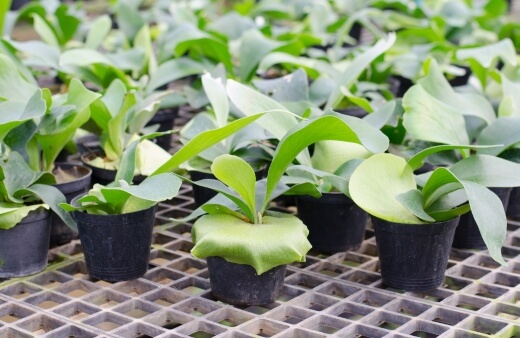
Propagating Staghorn Fern from Leaf Cuttings or Spores
Staghorn ferns have two types of leaf, fertile fronds, and basal fronds. The fertile fronds have small spores across their base, which turn a rusty orange when ripe.
When you have a leaf, full of ripe spores, simply cut off a leaf and lay it onto a tray of moist coconut coir. Cover the whole setup with a plastic bag, and check it every week in case it needs extra water.
After 4-6 months, the spores will start to show signs of life. Find a warm, shaded spot but leave the tray undisturbed other than misting for another 6 months until there are definable young ferns.
Then move them into individual pots full of bark, leaf litter, and/or moss and keep them moist until they are ready to attach to a board or tree.
Read more about the types of plant cutting and how to take them here.
Staghorn Fern Propagation from Division
A significantly quicker way to get one or two new plants is division. Ferns of all species can be divided this way but it works particularly well for staghorn ferns. All you need is a serrated knife (a bread knife will do) and a steady hand.
Find the centre of the root, and cut straight down the middle, keeping fronds on both halves. Leave one half in place, and move the other to a new position with some moss to help it root.
Alternatively, you can take pups by gently cutting away smaller sections of root around young plants that have developed near, or from the original root.
These can be attached directly to a plank or a tree, but benefit from a year in moist coir or mossy compost.
Common Staghorn Fern Pests and Diseases
If you grow staghorn ferns indoors they are almost definitely going to attract mealybugs, aphids, scales, and /or thrips. All of these can be dealt with using rubbing alcohol and are not a sign of unhealthy plants.
These insects cause very little harm to ferns, but if you notice yellow, brown, or orange spots, treat the leaves with an organic fungicide like horticultural soap.
Staghorn ferns growing outdoors in Australia rarely get diseases as most are fungal or root based, and occur as a result of being planted in typical potting compost when bought as house plants.
In extremely humid conditions, leaf-spot, root rot, botrytis, and powdery mildew can affect staghorn ferns. To treat them, use a fungicidal spray, and reduce watering after removing any diseased foliage to prevent its spread to other parts of the plant, or nearby ferns.
Staghorn Fern Frequently Asked Questions
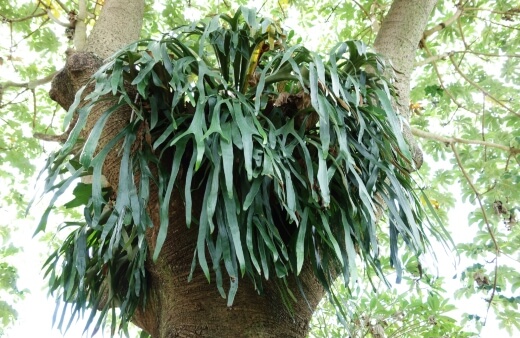
Can staghorn ferns grow in pots?
Staghorn ferns can grow in pots, but should never be planted in nutrient or mineral-rich compost. Ideally, staghorn ferns should be planted into moisture-retentive organic matter like bark chip, orchid bark, peat moss, or even straw (if you’re desperate), but the main rule is that water should never sit around the pot.
How often should you water a staghorn fern?
Water staghorn ferns once a week in hot, dry weather, particularly in covered locations, and mist through winter if the weather is cold but dry. Avoid watering if rain has already done the job!
Does a staghorn fern require extra watering?
Most staghorn fail due to overwatering. To ensure that fern has enough water check the coconut coir in the centre of the plant. If it is still moist and spongy, leave it for a day or two. If it is drying out, then it is time to water again.
Why are the tips of staghorn fern turning brown?
Brown tips on staghorn ferns indicate under-watering or overexposure to sunlight. In both cases, it is an unequal balance of light and water that causes leaves to struggle.
If you address the balance, they will recover well, and within a few months, the brown spots should be gone.
Does my staghorn require fertiliser?
Yes. Many gardeners use a dry fertiliser when mounting or remounting ferns and the supplement this with a liquid fertiliser. Liquified worm castings or seaweed extract would be appropriate during the growing season.
What is the best fertiliser for staghorn ferns?
Outdoors, staghorn ferns will make their own fertiliser from falling leaf litter, feathers, etc. Just natural mulches within the crown. Indoors, or in covered spaces, staghorn ferns should be misted with a diluted balanced feed (anything with an NPK of 10-10-10 or 5-5-5, etc.)
How do I take care of my staghorn fern?
If the staghorn becomes too large for the mounting board, then it may be time to remount it. Repeat the process that you performed when mounting the fern but increase the dimensions of the board to accommodate extra growth.
Staghorn have very few pests but the ones that do like these types of ferns are mealy bugs and scale. You may want to steer away from oil-based solutions as these can blemish the fronds.
Grow your staghorn in filtered light where it won’t come into contact with direct sunlight at any time during the day.
Staghorns will surely add that extra tropical feel to your garden. For more Australian native tropical plants, be sure to check out our list here.
Add Tropical Drama to Your Garden by Growing Starhorn Ferns
If you want to bring the tropics right into your garden, there are few simpler ways than to introduce a staghorn fern. Their huge, architectural fronds add drama to green spaces and can make your garden feel like the secluded haven you’ve always dreamed of.
If you’re gardening on a balcony or with a small garden like me, you’ll need to choose your staghorn varieties wisely, but once you find the right one, you’ll wonder why you ever lived without it.
Published on October 1, 2022 by Lorri Hopkins
Last Updated on February 22, 2024

